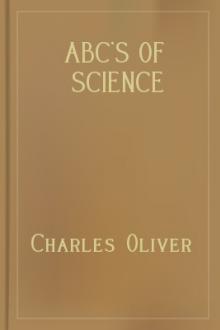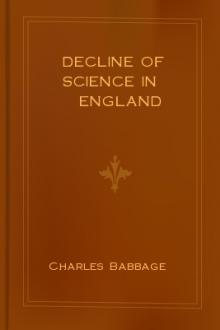ABC's of Science, Charles Oliver [classic books for 12 year olds TXT] 📗

- Author: Charles Oliver
- Performer: -
Book online «ABC's of Science, Charles Oliver [classic books for 12 year olds TXT] 📗». Author Charles Oliver
3.
Mineral is comprised of Mineral Matter and Mineral Magnetism.
4.
Animal is comprised of Animal Matter and Animal Magnetism.
5.
Vegetable is comprised of Vegetable Matter and Vegetable Magnetism.
6.
Each of the foregoing have life, and by cooperating with each other produce life that flourishes.
7.
There being as many different kinds of Magnetism as there are matter which is beyond the strength of human to classify.
8.
The supreme power of Nature had no beginning so it has no end; its life is indestructible.
[Figures: Five line-drawings, captioned as follows. “Comet of 1881, the year Mother Shipton prophecied the Earth to come to an end.” “Comet of 1744.” “Comet of 1857.” “Biela’s comet discovered in 1827. returned at intervals of 6 1/2 years. In 1846 it returned split, returned in 1852, but never appeared since.” “Saturn.”]
(The word “vapor” used in general for water, ice, atmosphere, etc.)
1.
Space without beginning or end, filled with unmaterial and material life. The material is in motion by the currents of unmaterial life.
2.
The material is in perfect bodies, imperfect bodies, and unconcentrated material.
3.
Perfect bodies group into constellation, called sun’s planets, planetoids, and moons.
4.
Imperfect bodies are comets, called periodic and parabolic comets.
5.
Unconcentrated material called Milky Ways, and rings such as are around Saturn.
6.
The unmaterial life currents run in every conceivable manner. I will call the currents carrying constellation sun currents, planet currents, planetoid currents, moon currents, and comet currents, respectively.
Milky ways eddys.
7.
Saturn is the only body we know which has an unconcentrated obsequious attendant. Such rings may appear around constellations, planets, moons, etc.
These rings can be accounted for in two ways,—first, the material never being concentrated; second, by two or more bodies coming together and throwing the bodies into atoms.
8.
Suck, or Nebula, currents form in the Milky ways (the same as two or more currents of air coming together and making a whirlwind), which concentrates the material into bodies, thus forming constellations and comets; also rings such as are around Saturn.
If a constellation is formed its current is called sun current, and here it continues to whirl with all its subordinate currents, planet, planetoid, and moon.
9.
Comets are caused by sun currents’ pressure forcing the suck currents at a great speed, and forces the comet current to pass through sun currents. Some comets pass in and out of their sun currents at regular intervals and are called periodic, i.e., its orbit is an ellipse.
Comets that are parabolic will never return to their starting point and travel wild.
10.
Bodies may be destroyed by suck currents carrying bodies in collision with each other; if the bodies are equal size, will throw the material into atoms. If a small and large body come in collision the small body will bury itself in the greater. Bodies thrown into atoms, the atoms may continue to be carried by its respective current (as rings around Saturn), or the atoms may be forced beyond its current and pass as shooting stars to other bodies or milky ways.
11.
Nebula is the suck current in the process of condensing material into bodies. Can be seen in Milky Way with naked eve.
[Figures: two line drawings, captioned as follows. “The solar system.” “The sun.”]
1.
The Solar System is better known to us, as the earth on which we flourish belongs to it.
2.
The System is comprised of one sun (star), eight major planets, Mercury, Venus, Earth, and one satellite, Mars and two satellites, Jupiter and seven satellites, Saturn, its rings and ten satellites, Uranus and four satellites, Neptune and one satellite, and some 600 planetoids, varying in size from 600 miles in diameter to mere rocks.
3.
The sun’s diameter is 866,000 miles. Rotates every 606 hours. The length of time its current carries the sun over its orbit is unknown. The sun remains a melted mass; its vibration is maintained; has but little vapor and its theme reflected on the surface of its obsequious attendants which gives them heat and light.
Dark spots caused by vapor becoming concentrated to the sun’s surface; these spots change.
4.
Mercury, the smallest major planet, also the closest to the sun. It is carried over its orbit about 36,000,000 miles from the sun, which requires 88 days to complete its course, and rotates once every 24 hours and 5 minutes. Its diameter is 3,000 miles and it has a suitable amount of vapor for animals and vegetables to flourish.
5.
Venus has the brightest lustre of our planets which is caused from enormous amount of vapor. It is carried over its orbit at about 67,000,000 miles from the sun, which requires 224 7/10 days to complete its course. Rotates once every 23 hours and 21 minutes. Diameter, 7,700 miles.
6.
The earth is carried over its orbit; main distance being 93,000,000 miles from the sun, which requires one year to complete its course, which is 680,000,000 miles:
MILES Earth’s diameter 8,000 Greater or equatorial 7,925 Less or polar 7,899 Difference on comparison 26
The earth rotates once every 23 hours, 56 minutes, and 4 seconds; has one satellite, which is carried over its orbit at a distance of 238,850 miles from the earth. Its diameter is 2,160 miles. The moon completes its orbit in 29 days, 12 hours, 44 minutes, and 2 seconds. Its currents touch the earth and cause the tide; also affects some plants of the phenomena verita; these plants are also affected by the sun.
Many years after the earth’s material began to flourish, a small body (whose crust was cooled) came in contact with the earth; this caused the earth’s crust to crack almost from pole to pole and formed North and South America. The eruptions in Europe, Asia, and Africa were greatly scattered. Australian soil is deficient in phosphorus, which shows it is foreign and represents the small body which did not entirely bury itself. This caused some of the earth’s land surface to be below the sea level; also caused the earth’s axis to change at a very slow rate of about 77 yards per year. This will require many thousands of years for the North Pole to become the South Pole. For many years the Polar star appeared “fixed” at the earth’s north axis.
7.
Mars is carried around the sun by its planet current at a distance of 140,000,000 miles, which requires 687 days, and rotates every 24 hours, 37 minutes, and 22 1/2 seconds. Diameter, 4,200 miles. Mars has two satellites and is not abundant in vapor which causes its reddish appearance, therefore vegetation and animals are scanty.
8.
Jupiter is the largest major planet. It makes a great jump from the sun of 483,000,000 miles, carried by its planet current to complete its orbit in 12 years. Rotates every 9 hours, 55 minutes, and 37 seconds. Diameter, 88,000 miles; has seven satellites. The climate has a very even temperature due to its fast rotation.
9.
Saturn, the beauty of the skies, carried by its planet current around the sun at its main distance of 883,000,000 miles (a greater distance of 400,000,000 miles than Jupiter) which requires about 29 1/2 years. Rotates once every 10 hours, 14 minutes, and 23 seconds. Diameter, 75,000 miles. It has ten satellites and three rings of unconcentrated material. The cape ring is about 9,000 miles across, the other two about 16,000 each. Diameter of rings about 170,000 miles, which makes the rings very close to the surface.
10.
Uranus is carried by its planet current around the sun at a great distance of 1,778,000,000 miles, which requires about 84 years. Rate of rotation unknown. Diameter, 31,000 miles. It has four satellites.
11.
Neptune is the farthest from the sun. Its main distance being 2,792,000,000 miles; carried by its planet current over its orbit once in 164 years, 9 months. Diameter, 37,000 miles. Period of rotation unknown. Has one satellite. At Neptune we haven’t taken a step but our next neighbor is across the divide. Let us have a fairy dream and travel from the sun to Neptune in a straight or direct course at the rate of 1,000,000 miles an hour; it would take us 116 1/3 days to reach Neptune.
[Figure: Line drawing, captioned “The solar system.”]
1.
Crossing the divide (Abyss) we encounter other systems of about 25,000,000,000, or the first magnitude. Our most powerful glass reaches the 16th.
Magnitude is very uneven and irregular, and beyond this there is no end.
2.
Many constellations have more than one sun, while others are double, quadruple, and multiple. It is estimated a brilliant star, and can be seen; of these over a million have been catalogued and only about 25 whose distance have been measured.
1.
The earth reached its state of concentration, and the vapor in great clouds enveloped the heavier substance. The earth being heaved up by volcanoes (caused by the vapor coming in contact with the heated material); as the vapor reached its state, rain fell on the earth crust, and thus rivers, lakes, and oceans were formed.
2.
Here animal and vegetable matter began to flourish.
3.
Great deposits of protoplasm became concentrated over the earth’s surface; from the deposits sprang all kinds of vegetables and animals that flourish, and many more families than inhabit the earth to-day became extinct.
4.
Vegetable matter began to flourish as its semen became concentrated, likewise animal matter. (This takes place to-day in different ways, principally in Marine varites. See Chap. I, par. 6.)
5.
Reproductions in all families that flourish; some families mix and their offspring will not reproduce. (Life cannot be destroyed, but flourishment can.)
6.
Man came from deposits of protoplasm (semen) as is produced for reproduction of man to-day. The deposits were of different kinds; each deposit brought forth its own branch of humanity, these branches being of different type and tongue. Later the tongue of one branch became learned by the other. From the different original tongues will give us a good estimate of deposits in number.
7.
Babies were nourished in the protoplasm deposits the same as they are in their mother’s womb. This nourishment came from the abundance of albumen which accompanied the semen in concentrating. As the babies matured they broke the crust of the deposit of protoplasm and put forth their heads and breathed the air; their bodies still remained in the albumen until they gained strength to feed themselves on the albumen. Here the babies broke the cord (navel cord) that brought nourishment into their bodies, as in the womb of a mother, and crawled around over the crust of the deposit where they came, feeding on its crust by putting it into their mouths. The babe has not forgotten it yet, as everything he gets that he can handle goes to his mouth. He learned to walk and talk to his brothers and sisters, and composed a language of their own. Here manhood and womanhood is reached.
8.
All animals came in like manner, but without a fluent language.
9.
Vegetable matter flourished and the earth is inhabited. All bodies that have atmosphere are inhabited. Atmosphere is vaporized protoplasm.
10.
Ten of the principal materials that produce flourishment are carbon, hydrogen, oxygen, phosphorus, potassium, nitrogen, sulphur, calcium, iron and magnesium; protoplasm contains everything; chemists have not been able to determine and classify protoplasm. (See Chap. I, par.
7.)
11.
Humanity varied much in size. The giant tribe





Comments (0)